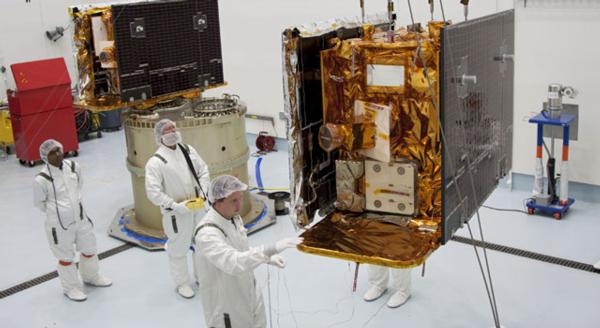Mon, Aug 29, 2011
Delta II Rocket Set To Boost The Satellites Towards The Moon
September 8th
NASA's Gravity Recovery And Interior Laboratory (GRAIL), mission
to study the moon is in final launch preparations for a scheduled
September 8 launch onboard a Delta II rocket from Cape Canaveral
Air Force Station in Florida. GRAIL's twin spacecraft are tasked
for a nine-month mission to explore Earth's nearest neighbor in
unprecedented detail. They will determine the structure of the
lunar interior from crust to core and advance our understanding of
the thermal evolution of the moon.

"Yesterday's (Thursday's) final encapsulation of the spacecraft
is an important mission milestone," said David Lehman, GRAIL
project manager for NASA's Jet Propulsion Laboratory in Pasadena,
Calif. "Our two spacecraft are now sitting comfortably inside the
payload fairing which will protect them during ascent. Next time
the GRAIL twins will see the light of day they will be about 95
miles up and accelerating."
The spacecraft twins, GRAIL A and B, will fly a circuitous route
to lunar orbit taking 3.5 months and covering approximately 2.6
million miles (4.2 million kilometers) for GRAIL-A, and 2.7 million
miles (4.3 million kilometers) for GRAIL-B. In lunar orbit, the
spacecraft will transmit radio signals precisely defining the
distance between them. Regional gravitational differences on the
moon are expected to expand and contract that distance. GRAIL
scientists will use these accurate measurements to define the
moon's gravity field. The data will allow mission scientists to
understand what goes on below the surface of our natural satellite.
"GRAIL will unlock lunar mysteries and help us understand how the
moon, Earth and other rocky planets evolved as well," said Maria
Zuber, GRAIL principal investigator from the Massachusetts
Institute of Technology in Cambridge.
GRAIL's launch period opens September 8 and extends through
October 19. On each day, there are two separate launch
opportunities separated by approximately 39 minutes.
More News
Inversion to Launch Reentry Vehicle Demonstrator Aboard SpaceX Falcon 9 This fall, the aerospace startup Inversion is set to launch its Ray reentry demonstrator capsule aboard Spac>[...]
"We are excited to accelerate the adoption of electric aviation technology and further our journey towards a sustainable future. The agreement with magniX underscores our commitmen>[...]
"The journey to this achievement started nearly a decade ago when a freshly commissioned Gentry, driven by a fascination with new technologies and a desire to contribute significan>[...]
Aero Linx: OX5 Aviation Pioneers Each year a national reunion of OX5 Aviation Pioneers is hosted by one of the Wings in the organization. The reunions attract much attention as man>[...]
"Our driven and innovative team of military and civilian Airmen delivers combat power daily, ensuring our nation is ready today and tomorrow." Source: General Duke Richardson, AFMC>[...]
 SpaceX to Launch Inversion RAY Reentry Vehicle in Fall
SpaceX to Launch Inversion RAY Reentry Vehicle in Fall Aero-News: Quote of the Day (04.23.24)
Aero-News: Quote of the Day (04.23.24) Aero-News: Quote of the Day (04.20.24)
Aero-News: Quote of the Day (04.20.24) ANN's Daily Aero-Linx (04.20.24)
ANN's Daily Aero-Linx (04.20.24) Aero-News: Quote of the Day (04.21.24)
Aero-News: Quote of the Day (04.21.24)



